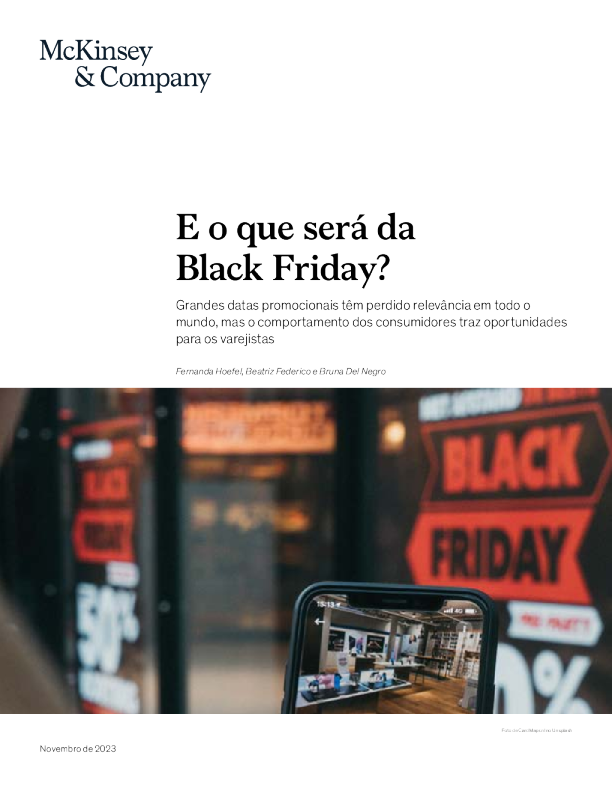什么将是黑色星期五的走势?| 巴西
 AI智能总结
AI智能总结
大型促销数据在全球范围内已经失去了相关性,但消费者行为为零售商带来了机遇。 费尔南达·霍费尔、贝阿特丽兹·费德雷科和布鲁娜·德尔·内格罗 当我们想到黑色星期五,脑海中首先浮现的场景是人们在商店门口排队或彻夜不眠地在线寻找特别折扣。自2010年进入巴西市场以来,这一活动获得了重要性,成为该国年度最重要的促销日期之一。在2022年,即便与世界杯和选举分摊关注度,该活动仍带动了34亿雷亚尔的消费。1 2023年,面对过去三年不寻常的背景。那些押注在强劲黑色星期五的人,可能会在11月份面临实现年度预算的困难;另一方面,试图在其他日期分散销售的商家可能会在消费者的心中(和钱包里)失去空间。 从展示巴西和全球大型促销日期演变趋势的格局出发,我们提出一些反思,以帮助品牌为新消费者的行为和预期做好准备,从而为其业务带来良好的成果。 然而,这股狂热已经减弱,零售商对应该采取哪种策略表现出不确定性。 世界范围内11月促销活动事件源头 在被称为黑色星期五之前,感恩节后的那个星期五——在美国是11月的第四个星期五——自1950年代以来就已经开启了该国圣诞节购物季节。从20世纪70年代中期开始,这个术语被普遍用来描述零售商开始大量回转的日期,此时商店顾客盈门。 不仅在美国,11月这个月还有一天是特别的日子来推动销售。自1993年以来,在中国,11月11日被庆祝为单身节,或称“双十一”——这个节日是由大学生们为了庆祝那些没有严肃恋爱关系的人(四个数字“1”代表四个单身的人)而创造的。这个日期仅于2009年成为商业活动的重要日子,当时阿里巴巴集团开始提供折扣和娱乐。 在墨西哥,最受欢迎的数据是“El Buen Fin”,这是一个在墨西哥革命日(11月第三个星期一庆祝)前的促销周末。在巴西,首个黑色星期五活动是在2010年举办的。该活动在2016年获得了更多关注,并成为年度零售业的主要事件之一。 大型促销活动的演变 最具潜力的品牌。在娱乐和创新的繁荣时期,为了提高参与度和不丢失利润,商店采用了复杂的游戏化策略来提供折扣。在那年的11月11日,该平台上售出了超过一百万件新产品,占总平台交易额的10%,创下了纪录。增长率再次回升。 出生与成熟 在2009年,当阿里巴巴在中国光棍节创建了一个商业活动时,想法很简单:在全品类提供大额折扣,以吸引新客户进行在线购物。通过创造需求高峰,这个日期加速了技术革新和业务支付及物流结构的改进,从而在2015年至2018年期间实现了快速增长。 在欧洲,该事件也迅速获得势头,在2022年,德国、法国和英国等国家,其在线销售额占总在线销售额的5%。在黑色星期五期间最受欢迎的类别仍然是电子产品和计算机,其销售额占各国总销售额的20%至35%,具体取决于国家,但美容和个人护理产品与往年相比也在增长。 在美国,黑色星期五活动起初以实体店和高端商品类别,如电子产品为主,这些商品足以让消费者排队等待数小时——许多人都记得那些标志性场景,人群在店铺内争夺空间。作为对实体店活动的回应,网上购物平台推出了网络星期一,紧随黑色星期五之后,许多商店开始采用持续时间更长的活动,甚至延续到一周。随着时间的推移,黑色星期五期间的网上购物参与率从2018年的18%增长到2021年的38%。2 增强与再定义 在中国,随着网络购物的普及,可获取的客户数量越来越少,增长势头减弱。随着越来越复杂的游戏化策略,消费者开始抱怨。结果是,在最新的版本中,出现了更不相关的折扣和更简单的机制。为了弥补这一点,在整个年度中,创造了新的降价销售活动。这种变化反映了新的焦点:如果吸引新消费者和商品总交易量(GMV)最初是重点,那么现在零售商更专注于吸引消费者,保护利润率。 与此同时,在中国,单身节(光棍节)在经过十年的繁荣之后开始显现出衰退的初步迹象,其增长速度低于往年前。为了区别于其他活动,2019年这一事件增添了一种创新色彩。阿里巴巴旗下电商平台天猫的半数商家开始利用直播销售产品,并且折扣也被扩展到了服务类目,旅游代理和美容院等机构也开始参与其中。风险投资基金也开始关注这一事件,以识别潜在的 麦肯锡公司 在美国,类似的停滞局面已经形成。黑色星期五的增长率从2020年起达到每年20%,但随后大幅下降。而所谓的“网络五天”(指感恩节星期四至网络星期一之间的五天)代表着年终节假日(11月和12月)线上销售的21%。 2019年12月,该数字降至2021年的16%。为了保持公众的参与度,一些零售商正在改变他们的策略并重新设定日期。专注于可持续性的公司正在推广提高消费意识的举措,而企业 尽管在大多数国家,黑色星期五仍然是电子商务年度最重要的活动,但它正逐渐被新的活动所取代,例如2022年7月和10月举行的亚马逊Prime Day。具体到意大利,2022年7月的亚马逊Prime Day成为了当年的最大电子商务活动。4 少数人于黑色星期五之后周六创立了“小企业星期六”。 观察谷歌搜索该术语的频率,可以发现对黑色星期五的兴趣在欧洲也呈现出下降趋势。在所有分析的 国家中,搜索峰值出现在2019-2020年,而在过去两年中显著下降(回到了疫情前水平以下)。 最高搜索量百分比,100% = 峰值年,按国家分类 麦肯锡公司 巴西正在发生什么 在2021年,该事件在通货膨胀率为10.06%(IPCA)的一年中仅实现了4%的微弱增长;在2022年,出现显著下降——由于11月这一非常规月份,总统选举两极分化以及世界杯期间,很少有人关注该事件,销售额下降了19%,回到了2019年的水平,不考虑通货膨胀因素。 过去五年中,巴西的黑色星期五经历了高潮和不确定性。在2018年至2020年间销售额持续稳定增长超过20%之后,接下来的几年呈现出截然不同的情景。 消费者和零售商感知 宏观、政治和社会环境在近三年内创造了无法作为标准的黑色星期五事件。缺乏比较基础产生了不确定性,并使零售商思考2023年应采取何种策略。 那么,这些变化是如何被巴西黑色星期五期间的买家和卖家所感知的?我们进行了一项针对500名消费者的调查,并与八家大型零售商的代表进行了交谈,以评估这种感知。 可能是向一个具有中国和美国市场行为特征的市场过渡阶段的开始,从集中在单一天的销售模式转向全年分散的(活动及促销)模式。任何过渡都意味着权衡取舍。为了保持相关性,企业需要适应消费者的行为和预期,即使在不能依赖黑色星期五来提振销售的情景下。 a. 消费者相关性与零售商目标 尽管去年销售额有所下降,黑色星期五在消费者心中仍占据重要地位,被视为年度最重要的促销活动。在零售商中,也存在类似的看法:大多数零售商预计2023年将实现收入增长。 一个看似导致这种巨大相关性的原因是,75%的消费者认为黑色星期五是一种提前购买圣诞节礼物且花费更少的购物方式。在这里,这与商家的预期是一致的: 在零售商之间,提高销售额是促销行动的主要动机之一,被所有人引述为主要目标在那天。在线渠道的渗透率提高位列第二,被一半的零售商所提及。 他们表示在活动周或11月整个月进行了采购。大多数零售商将2022年黑色星期五的促销活动维持了超过两周。 b. 持续时间 CEm vez de estar concentrado em um dia só,o período promocional vem se estendendo poruma semana ou um mês inteiro: 70% dos respondentes 与其集中于某一天,促销期正在延长至一周或整整一个月:70%的受访者 传统的信息渠道——如电视和商店橱窗——以及数字渠道——如社交媒体和网站——在传播优惠和促销方面具有相似的相关性。 c. Canais 消费者行为凸显了多渠道战略的重要性。参考资料 在购买时刻,全渠道也显现出来:仅有9%的人声称他们仅在线下门店进行购物,而69%的人表示他们在线上和线下都进行了购物。随着... 部分受访者表示将他们的购买在两个渠道之间分配,在巴西的黑色星期五,尽管数字化日益增长,实体空间仍然很重要。 观察2023年1月巴西零售商实施的折扣,我们会发现这些折扣甚至比2022年黑色星期五的折扣还要大。例如,2023年前几天最受欢迎的手机型号的平均折扣为16%,而黑色星期五期间的折扣为15%。5在促销折扣被认为真实时未能同步的沟通努力构成品牌必须避免的声誉风险。 d. 折扣 期待在购物季找到大折扣和购买机会可能会引起挫败感。在未参与上一届黑色星期五购物的消费者中,缺乏吸引人的促销——无论是总体上还是针对特定产品——的回应占到了一半以上。 在零售商一侧,大部分受访人士预计在未来几年黑五期间实施折扣将与目前持平或更低。即便如此,企业认为在线销售占比将会增加。 产品价值(o valor do produto)作为主要策略。如累计折扣和“买三送二”或由游戏化激活的促销等机制在受访者中偶尔出现。 e. 分类 企业所采用的机制往往较为传统。所有企业都提到了简单折扣的使用(一个百分比关于...)。 服装和配饰,以及手机和电脑,在上一届黑色星期五的受访者中被评为购买最多的类别。 消费者的行为在不同产品类别中并非同质化。电子产品——如电视、音响设备、手机和电脑——代表了消费者最常关注的类别。 飞机上购物。对于服装和美容产品,如香水和个人护理用品,购买趋势是冲动购买。零售商需要理解和考虑这些行为在其策略中。 大多数消费者更倾向于在已知的商店和品牌进行Black Friday购物,但在其中也存在发展新关系的机遇。 电器和个人护理用品销售 – 客户愿意了解新商店和品牌的 主要类别。如何为即将到来的变化做好准备 如何为即将到来的挑战做好准备 消费者视角,但又不失其本质。 考虑到消费者和零售商的观点,这一点无可置疑,即该事件的重要性依然很高。尽管过去两年销量有所下降,但该事件仍然是消费者心中的“首要之事”。随着一个不同于往年十一月的预期,2023年的黑色星期五应预示该日期未来几年的趋势。 在全年引起关注 Um dos motivos pelos quais o Black Friday eo Dia dos Solteiros estão em declínio na China, nos EUA e na Europa é que os consumidores encontram oportunidades de compra comdescontos semelhantes ao longo do ano. O Amazon Prime Day, criado em 2015 para celebrar os 20 anos da empresa, é um exemplo dessa prática. Outra iniciativa é o Super BrandDays, da chinesa Tmall, uma data em que diversas marcas oferecem promoções e experiências únicas. Já o marketplace Shopee promove eventos promocionais em todos os dias em que o número do dia e do mês coincidem. 无论如何,无论结果如何,全球零售商在过去一年中持续创造了不断的机会,以减少对能够影响年度结果的单一事件的过度依赖。在寻求实现业务更高可持续性的机会中,我们确定了五个最为相关的行动领域。 开发个性化引擎,以提供正确的产品。 1. 重新定义黑色星期五 零售商可以利用黑色星期五期间在线和实体店更大流量的机会,为该活动赋予新的意义,使其在市场上脱颖而出。 个性化比以往任何时候都更重要,尤其是在疫情加剧了消费者对其数字体验期望之后。麦肯锡进行的一项研究研究显示,71%的消费者期望企业提供个性化互动,而当这种




